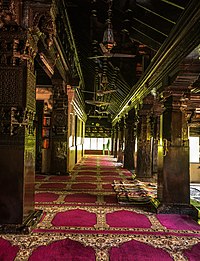Our website is made possible by displaying online advertisements to our visitors.
Please consider supporting us by disabling your ad blocker.
Hyderabadi Muslims
 The portrait of the VIIth Nizam | |
| Total population | |
|---|---|
| 2,187,005 (1941)[1] 1.71 million (2011) in Hyderabad district[2] | |
| Regions with significant populations | |
| Languages | |
| Standard Urdu (Deccani and its sub-dialect Hyderabadi Urdu), Telugu English and the vernacular languages of other countries in the diaspora | |
| Religion | |
| Related ethnic groups | |
| Dakhini Muslims • Muhajir people • Other Indian Muslim communities |
| Part of a series on |
| Islam in India |
|---|
 |
Hyderabadi Muslims, also referred to as Hyderabadis,[3][4] are a community of Deccani people, from the area that used to be the princely state of Hyderabad in the regions of Marathwada, Telangana, and Kalyana-Karnataka.[5][page needed][failed verification]
While the term "Hyderabadi" commonly refers to residents in and around the South Indian city of Hyderabad, regardless of ethnic origin, the term "Hyderabadi Muslims" more specifically refers to the native Urdu speaking ethnic Muslims of the erstwhile princely state.[6][page needed] The collective cultures and peoples of Hyderabad Deccan were termed "Mulki", (countryman), a term still used today.[7][page needed] The native language of the Hyderabadi Muslims is Hyderabadi Urdu, which is a dialect of the Deccani language.[citation needed]
With their origins in the Bahmani Sultanate and then the Deccan sultanates, Hyderabadi culture and cuisine became defined in the latter half of the reign of the Asif Jahi Dynasty in Hyderabad. The culture exists today mainly in Hyderabad, Aurangabad, Parbhani, Nanded, Raichur, Bidar, Gulbarga, and among the Hyderabadi Muslim diaspora around the world, in particular, Pakistan,[8] the Arab states of the Persian Gulf, USA, Canada and the United Kingdom.[9]
- ^ "Census of India 1941 Vol-xxi H.e.h. The Nizams Dominions (Hyd State)". 1947.
- ^ "Census of India Website : Office of the Registrar General & Census Commissioner, India".
- ^ Falzon, Mark-Anthony (15 April 2016). Multi-Sited Ethnography: Theory, Praxis and Locality in Contemporary Research. Routledge. ISBN 978-1-317-09319-0.
- ^ Leonard, Karen Isaksen (2007). Locating Home: India's Hyderabadis Abroad. Stanford University Press. ISBN 978-0-8047-5442-2.
- ^ Kate, P. V. (1987). Marathwada Under the Nizams, 1724-1948. Mittal Publications. ISBN 978-81-7099-017-8.
- ^ Gmelch, George; Kuppinger, Petra (3 January 2018). Urban Life: Readings in the Anthropology of the City, Sixth Edition. Waveland Press. ISBN 978-1-4786-3690-8.
- ^ Leonard, Karen Isaksen (2007). Locating Home: India's Hyderabadis Abroad. Stanford University Press. ISBN 978-0-8047-5442-2.
- ^ "Hyderabadis in Pakistan still carry mohajir tag: Karen Leonard". The Times of India. 7 January 2012. Archived from the original on 26 January 2013. Retrieved 30 April 2012.
- ^ "The Muslim question". The Times of India. 11 November 2011. Archived from the original on 3 January 2013. Retrieved 16 April 2012.
Previous Page Next Page



